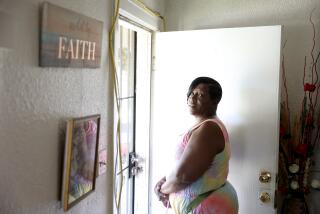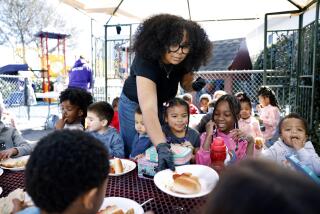A Link to Child SHARE Program : Churches Could Serve Important Function in Foster Care
A policeman knocks on the front door. Parents solemnly hand over their 4-year-old, who is whisked away in a patrol car. The child is taken to a large county facility where he or she does not see any familiar faces, and the ones the child does see are different at night than the ones during the day.
According to Mary Rotzien, this is what is experienced by more than 400 children younger than 5 years old who are taken into protective custody each month in Los Angeles County. Already the victims of physical or sexual abuse, abandonment, physical neglect or exposure to drugs, these children often believe they have been arrested and taken to jail.
Unfortunately, such an experience plays directly to the emotional vulnerabilities of such children. “An abused child already has an internal sense of guilt,” Rotzien said, and assume they have been bad. “They can’t reason that the parent is the one with the problem.”
This scenario, which Rotzien said she saw many times as an intern at Los Angeles County’s MacLaren Children’s Center, inspired her to lay the groundwork for Child Shelter Homes: A Rescue Effort, a program designed to provide foster care for children under 5 years who have been picked up by protective services.
A Twofold Problem
The Child SHARE Program addresses a twofold problem that has long vexed child care authorities. Virtually everyone agrees that children in protective custody are best off in the care of dedicated and nurturing foster parents. But there are not enough foster parents to go around. “There is a huge need for high-quality foster parents,” said Judith Lau, director of the Children’s Bureau, a private organization licensed by the state to certify foster homes.
For children who can’t be placed with temporary foster parents, the shelter of last resort is the MacLaren Center, which even county authorities concede is overcrowded.
According to figures compiled by the county’s Bureau of Program Resources, 345 children under the age of 5 were taken into protective custody in September, 1985. On Oct. 24, 1985, 61 toddlers were in the facility’s nursery, which was built to take care of 13 children. The average nursery population from August 1984 through August 1985 is 65 children.
“We’re real excited about it (the Child SHARE Program),” said Jean McIntosh, deputy director of the Bureau of Program Resources. The county is providing assistance to the new program by helping to license and train temporary foster parents and by providing a referral service to match up toddlers with temporary foster parents.
Rotzien’s answer to the twin problems of overcrowded public facilities and undersupply of temporary foster parents was to turn to her church. “It’s a recruiting of a population that hasn’t been tapped,” she said.
First to Participate
The Westwood Presbyterian Church is the first to participate in the program, with the first set of foster parents, John and Joyce Purvis of Los Angeles, taking custody of 16-month-old Rhonda (confidentiality prevents disclosing the child’s full name) in mid-October.
According to Joyce Purvis, Rhonda arrived with one dress, one toy and a runny nose. Rhonda had been in MacLaren Hall for about a month. She previously lived with her grandmother in an automobile. “There was love there,” Joyce Purvis said. “It’s a sad story, but not a tragic story.”
Purvis said the grandmother has since been able to move to a motel room with a friend, and all parties hope that when the grandmother finds a permanent and suitable place to live, Rhonda will be returned to her. The Purvises were told that they would be Rhonda’s foster parents for two to 12 weeks.
“She is learning to talk very fast,” Joyce Purvis said. “And she is very curious.”
Eased the Frustrations
Rotzien said making the first placement has eased the frustration of dealing with a foster parent licensing process that can be excruciatingly slow. Simply processing the fingerprints of foster parent applicants can take as long as five months, she said.
“Ignorance is bliss,” she added. “If we knew how hard it was going to be, we might not have done it.”
The Hollywood Presbyterian Church is also planning a Child SHARE Program. Rotzien believes the second SHARE chapter is approximately three months away from making its initial placement. Brian Buchanan, co-director of the program, said he and Rotzien, who is his wife, would like to see the Child SHARE concept spread to other religious denominations.
Lau believes that churches can reach the type of foster parents who are likely to stick with the program. “They can reach people who are motivated to serve,” she said.
The Children’s Bureau is lending support to the Child SHARE Program by providing training, supervision and counseling and by making a social worker available to interview prospective foster parents.
Potential Foster Parents
In interviewing potential foster parents, Lau said the Children’s Bureau looks for motivation, capacity to nurture, expectations of children, attitudes and experience in disciplining children.
Lau believes that the promise of the Child SHARE Program lies not only in the dedicated pool of people who want to become foster parents, but in the support available to them as well.
“It’s such a difficult job” to be a foster parent, temporary or otherwise, she said. Some foster parents quickly find that they have gotten in over their heads. With church members providing strong back-up support, the failure rate can be diminished, Rotzien believes.
Buchanan said that the program works with church congregations, rather than with the general public, to build support services through the social network available within each church.
Rotzien said there are several reasons why persons recruited under the Child SHARE Program would be less likely to drop out of foster parent activities.
Child SHARE foster parents will generally take custody of only one child at a time, although in some cases there may be families willing and able to take siblings. Temporary foster parents often take two children at a time, while county facilities sometimes have five toddlers for one care giver. “It is hard to be so giving to so many needy children,” she said.
Close-Knit Aspect
Rotzien believes that the close-knit aspect of the program will lead to better training of foster parents. Better-trained people, presumably, are less likely to run up against situations for which they are unprepared and get discouraged. She believes that is a problem with current shelter-care programs.
All foster parents are given training in first aid and CPR for young children. They must also attend a seminar in which the emotional needs and peculiarities of the abused child are discussed.
The first such seminar was given recently by Wes Vincent, a doctoral candidate in clinical psychology. He said abused children generally feel fear, bewilderment and guilt. They become fearful because they have “learned to view their environment as threatening and painful,” Vincent said. Bewilderment ensues because the child has been treated inconsistently, with abuse being inappropriate to the child’s behavior.
“They need to be given a little more free rein, yet need firmer guidance,” than children with less traumatic backgrounds, he said. “They need to be given guidelines and corrective behavior in a caring and gentle way” in order to gain a strong idea of right and wrong.
Fear of Affection
He said that abused children may also have a fear of affection. “They don’t quite know what’s going on,” he said. For example, hugging by an adult may signify violence, not love, to a child who has been repeatedly beaten up, then hugged by a remorseful parent.
Sexually abused children often have anxieties about male adults. They may be afraid of separating from an adult female, because in the past the abuse generally didn’t occur when the child’s mother was present. Some sexually abused children have “sleep terrors,” in which they wake up sobbing and crying. This is because the abuse generally came at night. Indeed, the child may be afraid to go to bed at night.
However, both Lau and Rotzien agree that perhaps the biggest single factor the Child SHARE Program has working for it is that the temporary foster parents will have a deep wellspring of support in their fellow church members.
Investor-partners--volunteers whose role is to provide support for the foster parents by offering short-term care, transportation, special expertise or material assistance--have been assigned to assist the Purvises and future foster parents.
Another person is in charge of an equipment co-op, which will provide high chairs, car seats, playpens and other baby and toddler-related items. Other volunteers will donate time to meet the psychological, medical, administrative, clerical and legal needs of the program.
More to Read
Sign up for Essential California
The most important California stories and recommendations in your inbox every morning.
You may occasionally receive promotional content from the Los Angeles Times.










